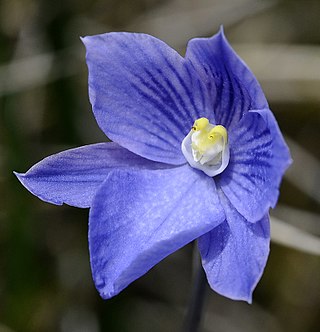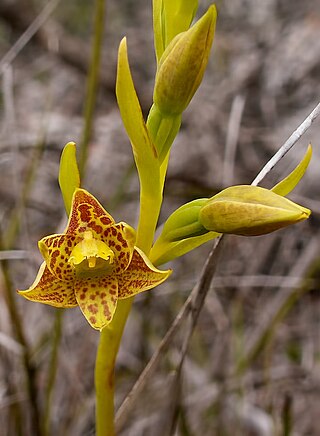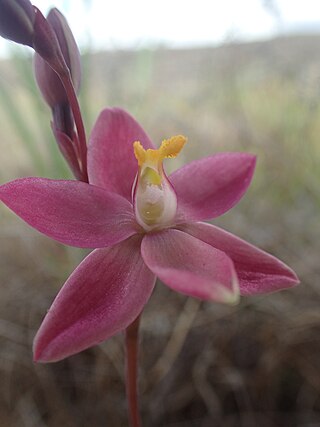
Pterostylis is a genus of about 300 species of plants in the orchid family, Orchidaceae. Commonly called greenhood orchids, they are terrestrial, deciduous, perennial, tuberous, herbs found in Australia, New Zealand, New Guinea, New Caledonia and one Indonesian island. The flowers are mostly green, sometimes with brown, reddish or white stripes, and are distinguished from other orchids by their unusual flower structures and pollination mechanism.

Diuris, commonly known as donkey orchids, bee orchids, nanny goat orchids or pansy orchids, is a genus of more than sixty species of flowering plants in the orchid family, Orchidaceae and is endemic to Australia, apart from one species endemic to Timor. The name "Diuris" refers to the hanging sepals but the common name "donkey orchid", derives from the ear-like petals common to all species. Many have mainly yellow flowers with darker markings and are thought to mimic nectar-producing flowers which open at the same time.

Thelymitra, commonly known as sun orchids, is a genus of more than 100 species of plants in the orchid family, Orchidaceae. Unlike most other orchids, sun orchids lack a highly modified labellum and all three petals are similar in size, shape and colour. The column is, however, highly modified and usually has prominent wings or glands which are helpful in identifying the species. Most sun orchids close their flowers at night, in cloudy or cool weather, giving rise to their common name. The scientific name means "woman's hood" and refers to the hooded column present in most, but not all species. Most species are endemic to Australia although some are found as far from there as the Philippines and Indonesia. The type species, Thelymitra longifolia, the first to be formally described, was collected in New Zealand.

Dipodium, commonly known as hyacinth orchids, is a genus of about forty species of orchids native to tropical, subtropical and temperate regions of south-east Asia, New Guinea, the Pacific Islands and Australia. It includes both terrestrial and climbing species, some with leaves and some leafless, but all with large, often colourful flowers on tall flowering stems. It is the only genus of its alliance, Dipodium.
Corunastylis is a historically recognized genus of about 50 species of orchids, native to Australia and New Zealand, now included in the genera Genoplesium and Prasophyllum.

Thelymitra macrophylla, commonly called the large-leafed sun orchid or scented sun orchid, is a species of flowering plant in the orchid family Orchidaceae, and is endemic to the south-west of Western Australia. It has a single thick, broad, leathery leaf and up to twenty five relatively large dark blue to purplish flowers with white, toothbrush-like tufts.

Genoplesium commonly known as midge orchids, is a genus of about 50 species of flowering plants in the orchid family, Orchidaceae and is found in Australia, New Zealand and New Caledonia. Midge orchids are terrestrial herbs with a single leaf at the base of the plant. They are similar to orchids in the genus Prasophyllum in that plants without flowers have a hollow, onion-like leaf. The flowers are small but often scented and attractive to their insect pollinators. There is disagreement about which species belong to this genus and some taxonomists suggest that most belong in the genus Corunastylis.

Lyperanthus, commonly known as beak orchids, is a genus of flowering plants from the orchid family, Orchidaceae, that is endemic to Australia. There are two species, one in Western Australia and the other in four eastern Australian states, distinguished by their single long, narrow, leathery leaf and dull coloured flowers which have prominent short calli on their labellum. Both form loose colonies which reproduce asexually from their tubers, and sexually using their flowers.

Thelymitra cyanea, commonly known as the veined sun orchid in Australia and as the swamp sun orchid or striped sun orchid in New Zealand, is a species of orchid which is native to New Zealand and south-eastern Australia. It has a single erect, fleshy, channelled leaf and up to five bright blue flowers with darker blue veins. It is usually found growing in swamps, sphagnum bogs, and subalpine herbfields, often in clonal colonies.

Thelymitra gregaria, commonly called the clumping sun orchid, is a species of orchid that is endemic to Victoria. It has a single fleshy, channelled leaf and up to six strongly scented, dark blue to purple flowers and often grows in clumps.
Thelymitra queenslandica, commonly called the northern sun orchid, is a species of orchid that is endemic to Queensland. It has a single long, grass-like leaf and up to fifteen dark blue to purplish, sometimes white or pinkish flowers with white or pink tufts on top of the anther. It is readily distinguished by its northerly distribution and early flowering period.

Thelymitra graminea, commonly called the shy sun orchid, is a species of orchid in the family Orchidaceae and is endemic to the south-west of Western Australia. It has a single leathery, channelled leaf and up to ten relatively small blue, self-pollinating flowers with white, toothbrush-like tufts on the top of the anther.
Thelymitra kangaloonica, commonly known as Kangaloon sun orchid, is a species of orchid that is endemic to a very small area of New South Wales. It has a single erect, relatively narrow, fleshy leaf and up to forty deep blue flowers with darker veins.

Thelymitra luteocilium, commonly called the fringed sun orchid, is a species of orchid that is endemic to south-eastern Australia. It has a single fleshy, dark green leaf and up to six pale pink to reddish flowers with a short wavy lobe on top of the column.

Thelymitra benthamiana, commonly called the leopard sun orchid or blotched sun orchid, is a species of orchid in the family Orchidaceae and is endemic to Australia. It has a single leathery leaf and up to ten yellowish green flowers with brownish spots, blotches and patterns. The column is yellow with deeply fringed wings and the lobe on top of the anther has a large lump on its top.

Thelymitra maculata, commonly called the spotted curly locks or eastern curly locks, is a species of orchid in the family Orchidaceae and endemic to the south-west of Western Australia. It has a single erect leaf, spiralling around the flowering stem and a single pink or purplish, spotted flower with more or less circular, yellow ear-like arms on the sides of the column.
Thelymitra variegata, commonly called the Queen of Sheba, is a species of orchid in the family Orchidaceae and endemic to the south-west of Western Australia. It has a single erect, spiral, dark green leaf with a purplish base and up to five glossy, variegated reddish, purplish or violet flowers with darker spots and blotches and yellowish margins. There are two bright yellow or orange arms on the sides of the column.
Thelymitra × chasmogama, commonly called the globe-hood sun orchid, is a species of orchid that is endemic to south-eastern Australia. It has a single tapering, channelled leaf with a reddish base and up to six bright pink flowers with pale yellow tufts on top of the anther. It is a natural hybrid between T. luteocilium and T. megacalyptra.

Thelymitra × macmillanii, commonly called the red sun orchid or crimson sun orchid is a species of orchid that is endemic to south-eastern Australia. It has a single tapering, channelled leaf and up to five bright red, sometimes yellow flowers. It is a natural hybrid between T. antennifera and T. carnea or T. rubra.














